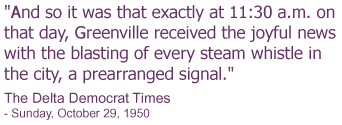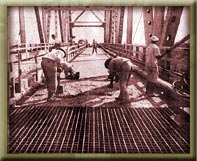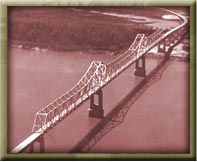|
(continued)

Where John A. Fox succeeded as a
master of politics, Mayor Milton C. Smith succeeded
as a master of finance, and  during
the year that followed, the Mayor’s skills would be
tested to the fullest. A survey of traffic volume, commissioned
to satisfy possible investors, concluded there wouldn’t
be sufficient income from tolls to warrant construction
of a $4.5 million bridge, and that the project merited
only $2.55 million in financing. The Reconstruction
Finance Corporation would lend the $2.55 million, but
this left Smith and Fox some $2 million short. during
the year that followed, the Mayor’s skills would be
tested to the fullest. A survey of traffic volume, commissioned
to satisfy possible investors, concluded there wouldn’t
be sufficient income from tolls to warrant construction
of a $4.5 million bridge, and that the project merited
only $2.55 million in financing. The Reconstruction
Finance Corporation would lend the $2.55 million, but
this left Smith and Fox some $2 million short.
 In
September 1938, Mayor Smith and City Attorney S.B. Thomas
went to Washington to seek money from the Works Progress
Administration (WPA), a Depression-era agency that provided
work for unemployed persons through the funding of public
works projects. Smith and Thomas had to convince the
WPA that construction of a bridge would furnish considerable
employment. The two made their case and the WPA agreed. In
September 1938, Mayor Smith and City Attorney S.B. Thomas
went to Washington to seek money from the Works Progress
Administration (WPA), a Depression-era agency that provided
work for unemployed persons through the funding of public
works projects. Smith and Thomas had to convince the
WPA that construction of a bridge would furnish considerable
employment. The two made their case and the WPA agreed.
On September 21, 1938, Smith and Thomas
sent a wire to Greenville with the news that their visit
had been successful and that "we could now look
forward to the actual materialization of our fondest
dream, the construction of the mammoth bridge."
By prearrangement, the word went out to the Greenville’s
steam plants — eight of them — and they blew their
whistles for ten minutes in celebration.
 Just
over two years later, on October 4, 1940, the US 82
Bridge over the Mississippi River was officially opened
to traffic. The bridge was named for Benjamin
G. Humphreys, a former United States Congressman
from Greenville who is credited for introducing the
term "flood control" to the American lexicon.
Humphreys was co-author of the Ransdell-Humphreys
Flood Control Act of 1917 which established a national
flood control program on the Mississippi, and delivered
thousands of people on the lower river from the worst
of the river’s wrath. Just
over two years later, on October 4, 1940, the US 82
Bridge over the Mississippi River was officially opened
to traffic. The bridge was named for Benjamin
G. Humphreys, a former United States Congressman
from Greenville who is credited for introducing the
term "flood control" to the American lexicon.
Humphreys was co-author of the Ransdell-Humphreys
Flood Control Act of 1917 which established a national
flood control program on the Mississippi, and delivered
thousands of people on the lower river from the worst
of the river’s wrath.
With the cutting of a ribbon by
Mildred McGee, Ben Humphrey’s granddaughter, the new
bridge was open. The city of Greenville was now a port
on a great east-west river of concrete.
|